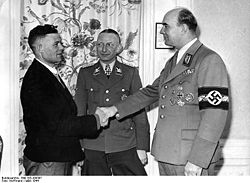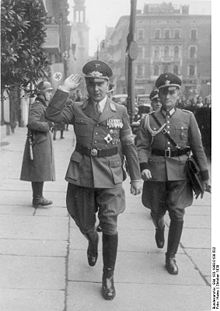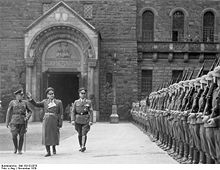- Arthur Greiser
-
Arthur Greiser 
President of the Free City of Danzig Senate In office
23 November 1934 – 23 August 1939Preceded by Hermann Rauschning Succeeded by Albert Forster
(as State President)Reichsstatthalter of Wartheland In office
1939–1945Appointed by Adolf Hitler Preceded by none Succeeded by none Personal details Born 22 January 1897
Schroda (Środa Wielkopolska), Province of Posen Kingdom of Prussia, German Empire, now PolandDied 21 July 1946 (aged 49)
Poznań, People's Republic of PolandPolitical party National Socialist German Workers Party (NSDAP) Arthur Greiser (22 January 1897 – 21 July 1946) was a Nazi German politician and SS Obergruppenfuhrer. He was one of the persons primarily responsible for organizing the Holocaust in Poland and numerous other war crimes and crimes against humanity, for which he was tried, convicted and executed by hanging after World War II.
Contents
Early life and career
Born in Schroda, Province of Posen, Imperial Germany, Greiser was the son of a minor local Gerichtsvollzieher (Bailiff). In 1903, he was enrolled at the Könglich-Humanistische Gymnasium (Royal Humanities College) in Hohensalza and is believed to have learnt to speak Polish fluently. In August 1914, he joined the Reichsmarine. After front line service in Flanders, in the Spring of 1917 he became a naval aviator. He served as a pilot on the Western Front. He earned the Iron Cross (First and Second Class), the Cross of Honour 1914–1918 Combatants medal, and a Wound Badge Black Class in 1914.
After the war and the loss of his homeland to Poland, he became particularly racist against Poles[citation needed]. From 1919 to May 1921, he served in the Freikorps Grenzschutz Ost and fought in the Baltic states.
Beginning career in the Nazi Party
Greiser was an early member of the Nazi party (Party number 166,635). After many years with the nationalist Deutschsoziale Partei of von Kunze and membership of the Stahlhelm in the mid-1920s, he joined the NSDAP and SA on 1 November 1929. He eventually joined the SS on 30 June 1931.[1] He was later awarded the prestigious "Golden Party Badge".
He was the Senate President and the head of state (Senatspräsident) of the Free City of Danzig (now Gdańsk, Poland) (1935–1939), and the administrator (Reichsstatthalter und Gauleiter) of Reichsgau Wartheland (1939–1945). As Senate President of Danzig, he was described as a “hothead” and was a serious rival to his nominal superior Albert Forster, the leader of the Nazi Party in that city since 1930. Greiser was part of the SS empire whilst Forster was closely aligned to the Nazi Party Mandarins Rudolf Hess and later Martin Bormann.
Greiser was directly responsible for escalating tensions between the Free City and the Republic of Poland in 1939. When the Polish Foreign Affairs Minister Józef Beck threatened economic reprisals following the harassment of Polish frontier guards and customs officers, Greiser issued an announcement on 29 July 1939 declaring that the Danzig police no longer recognised their authority or power and demanded their immediate withdrawal. The notice was so rudely worded that the Polish diplomatic representative to Danzig, Marian Chodacki, refused to forward it to Beck and instead sent a curt summary.
World War II
 Arthur Greiser welcoming the one-millionth Volksdeutcher resettled from East Europe to occupied Poland as part of the "Heim ins Reich" campaign - March 1944
Arthur Greiser welcoming the one-millionth Volksdeutcher resettled from East Europe to occupied Poland as part of the "Heim ins Reich" campaign - March 1944
Immediately following the German invasion of Poland, Greiser was transferred from Danzig and appointed “Chef der Zivilverwaltung im Militärbezirk Posen” or Chief of Civil Administration in the military district of Greater Poland, which was annexed to the German Reich on 8 September 1939. The military administration ended the following month, and he was then appointed Gauleiter (21 October) and "Reichsstatthalter für den Reichsgau Posen" (26 October). On 29 January 1940, the region was renamed Reichsgau Wartheland. The territory was potentially very rich - the Prussian Imperial province of Posen had been the breadbasket of Wilhelmine Germany before 1914, possessed an excellent rail and road network, and a comparatively healthy and well educated workforce; Litzmanstadt had developed a fairly sophisticated industrial base during the 19th century. Although every Gauleiter was expected to fully Germanize their assigned area by any method,[2] Greiser emphasized brutality to achieve this goal. He was an ardent racist who enthusiastically pursued an 'ethnic cleansing' program to rid the Warthegau of Poles and to resettle the 'cleansed' areas with ethnic Germans.[3] This was along the lines of the racial theories espoused by SS Reichsführer Heinrich Himmler. Mass expulsions of Poles from the Warthegau to the General Government and summary executions were the norm. A Polish servant in Greiser's house described him as "...a powerfully built figure. He was a tall man, you could see his arrogance, his conceit. He was so vain, so full of himself-as if there was nothing above him, a god, almost. Everybody tried to get out of his way, people had to bow to him, salute him. And the Poles, he treated them with great contempt. For him the Poles were slaves, good for nothing, but work".[4] Greiser himself stated his beliefs: "If, in past times, other peoples enjoyed their century-long history by living well, and doing so by getting foreign peoples to work for them without compensating them accordingly and without meting out justice to them, then we too, as Germans want to learn from this history. No longer must we stand in the wings; on the contrary, we must altogether become a master race!".[5]
In addition to mass deportation, Greiser's district was also at the forefront of "internal" racial cleansing according to Nazi ideals. His subordinate Wilhelm Koppe provided the 'Special Detachment (Sonderkommando) Lange' to the nearby Gau of East Prussia during May and June 1940. This SS squad gassed 1558 patients from mental asylums at the Soldau concentration camp and then returned to his region to continue this process.[6]
Perhaps the only evidence of humanitarian acts in his career was his involvement in the resettlement of German refugees from lands annexed to the Soviet Union over 1939 to 1940. Between October and December 1939 nearly 60,000 Volksdeutsche arrived in Germany from the Baltic states of Estonia and Latvia. Evidently Wilfried Strik-Strikfeldt (later employed as translator for General Andrey Vlasov) was in this group as he "resettled" in Posen. Neighbouring Gauleiter and rival Albert Forster refused them entry point blank and they were largely settled in properties seized from Poles in Poznań and across the Wartheland. However even Greiser was wary, noting that many were elderly and urbanized aristocrats with a strong class consciousness, not the virile peasant warrior types idolized by the SS. Closer to his heart were the over 100,000 Volksdeutsche who were evacuated from Volhynia and eastern Galicia. These were mostly farmers and rural people, and, learning from the Baltic experience, Łódź in eastern Wartheland was designated the main Volksdeutsche Mittelstelle (VoMi) reception centre. In May 1940 a further 30,000 Volksdeutsche were relocated from the Nazi General Government of Poland to Greiser’s domain. After 1941 a further 300,000 Volksdeutsche were evacuated from Russia and Ukraine to Wartheland during the German invasion and occupation of the Soviet Union.
Greiser’s Poznań was considered the Germanised city par excellence and on 3 August 1943 he hosted a national gathering of Gauleiter and senior Nazis, including Martin Bormann, Joseph Goebbels and Heinrich Himmler.
SS Obergruppenführer Greiser was fully aware of the Holocaust and actively participated in it. Early in 1940, Greiser is on record challenging Hermann Göring over efforts to delay the expulsion of Łódź Jews to Poland. On 18 September 1941 SS Reichsführer Heinrich Himmler informed Greiser that he intended to transfer 60,000 Czech and German Jews to the Łódź ghetto, until spring 1942 when they would be "resettled". The first transport arrived a few weeks later, and Greiser sought and received permission from Himmler to kill 100,000 Jews in his area.[7] He then instructed HSSPF Wilhelm Koppe to manage the overcrowding. Koppe and SS Sturmbannführer Herbert Lange proceeded to manage the problem by experimenting at a country estate at Chełmno nad Nerem with gas vans, establishing the first extermination unit which ultimately carried out the mass murder of approximately 150,000 Jews between late 1941 and April 1942. Furthermore on 6 October 1943 Greiser hosted a national assembly of senior SS officers in Posen at which Himmler candidly spoke of the mass executions of civilians (the infamous Posen Speech).
On 20 January 1945, Greiser received a telegram from Bormann relaying Hitler's order to leave the city. Although Hitler also ordered Stronghold Poznań to be held at all costs, the city fell to the Soviet army eight days later. Joseph Goebbels objected to his actions towards the end of the war. In Goebbels' diary entry of 2 March 1945, he labeled Greiser "a real disgrace to the (Nazi) Party.", but his recommendations for punishment after the capture of Poznań were ignored.[8]
He surrendered to the Americans in Austria with SS Obergruppenführer Heinz Reinefarth in 1945.
Trial and execution
After the war, the Polish government (the Supreme National Tribunal) tried him for war crimes. His defense that he was only following orders did not hold up as it was shown that other Gauleiters had not followed a similar policy. For example, Albert Forster, Gauleiter of Danzig-West Prussia (the other German-annexed section of occupied Poland), simply declared all Poles in his area who were reasonably proficient in German to be Germans (although he was guilty of the elimination of the Jewish population under his jurisdiction either by murder or deportation). Greiser's advocates, Stanisław Hejmowski and Jan Kręglewski, tried to convince the Tribunal that Greiser, as a head of formally independent state, the Free City of Danzig, could not be judged by another country, an argument rejected by the court. Greiser was convicted for:
- Genocide and the murders of civilians and POW
- Torture, persecution, and injuring civilians and POWs
- Organized and systematic destruction of Polish culture, plunder of Polish cultural heritage, Germanisation of the country and the Polish people, illegal appropriation of public property.
- Organized and systematic looting of Polish property
- Insulting and deriding the Polish nation by propagating its cultural inferiority and low social worth
- Forcible expelling of whole districts, streets, families and singular persons to General Government or forced labor camps in German Reich
- Persecution and murder of Polish Jews by killing them in place of residence, grouping in closed ghettos from where they were send to Chelmno extermination camp for extermination in gas chambers, deriding the Jewish people in actions and words, causing physical suffering, injury and humiliation of human dignity
- Taking Polish children against the will of their parents or guardians, forcibly putting them in German families or public orphanages within the Reich while breaking all contacts with their family and nation by giving them German names
The Tribunal decided that Greiser was guilty of all charges, and sentenced him to death by hanging, civil death, and confiscation of all his property. In the early morning of 21 July 1946 he was transported from prison to the slope of Fort Winiary where he was hanged before a large crowd.[9] It was the last public execution in Poland.[10]
Endnotes
- ^ http://forum.axishistory.com/viewtopic.php?t=87731
- ^ Ian Kershaw, Hitler 1936-1945: Nemesis, p. 251
- ^ Rees, Laurence The Nazis: A Warning From History, New York: New Press, 1997 pages 143-145
- ^ Rees, Laurence The Nazis: A Warning From History, New York: New Press, 1997 pages 142
- ^ Rees, Laurence The Nazis: A Warning From History, New York: New Press, 1997 pages 145
- ^ Ian Kershaw, Hitler 1936-1945: Nemesis, p. 261
- ^ Ian Kershaw, Hitler 1936-1945: Nemesis, p. 484
- ^ Ian Kershaw, Hitler 1936-1945: Nemesis, p. 1019
- ^ Catherine Epstein: Model Nazi: Arthur Greiser and the Occupation of Western Poland, p. 334-335
- ^ http://wiadomosci.polska.pl/kalendarz/kalendarium/article.htm?id=223986
References
- Ailsby, Christopher (1997). SS: Roll of Infamy. London: Brown Books. ISBN 1-897884-22-2.
- Dwork, Deborah; van Pelt, Robert Jan (1996). Auschwitz 1270 to the Present. New York: W.W. Norton & Company, Inc. ISBN 0-393-03933-1.
- Epstein, Catherine (2010). Model Nazi: Arthur Greiser and the Occupation of Western Poland. Oxford: Oxford University Press. ISBN 978-0-19-954641-1.
- Hüttenberger, Peter (1969). Die Gauleiter: Studie zum Wandel des Machtgefüges in der NSDAP. Stuttgart: Deutsche Verlags-Anstalt. (= Schriftenreihe der Vierteljahrshefte für Zeitgeschichte).
- Kershaw, Ian (2000). Hitler 1936-1945: Nemesis. New York: W.W. Norton & Company, Inc. ISBN 0-393-04994-9. Google Books link.
- Lilla, Joachim Bearbeiter (2004). Statisten in Uniform: Die Mitglieder des Reichstags 1933–1945. Düsseldorf: Droste Verlag. ISBN 3-7700-5254-4.
- Lumans, Valdis O. (1993). Himmler’s Auxiliaries. Chapel Hill: University of North Carolina Press. ISBN 0-8078-2066-0.
- Rees, Laurence (1997). The Nazis: A Warning From History. New York: New Press. ISBN 1-56584-551-X.
- Reitlinger, Gerald (1956). The SS: Alibi of a Nation 1922-1945. London: Arms & Armour Press. ISBN 0-85368-187-2.
- Schenk, Dieter (2000). Hitlers Mann in Danzig: Gauleiter Forster und die Verbrechen in Danzig-Westpreußen. Bonn: Dietz. ISBN 3-8012-5029-6.
Government offices Preceded by
Hermann RauschningDanzig Head of State
1934–1939Succeeded by
Albert ForsterThe Holocaust in Poland - Main article: The Holocaust
- Related articles by country:
- Belarus
- Estonia
- Latvia
- Lithuania
- Norway
- Russia
- Ukraine
Camps, ghettos and operations Camps ExterminationMass shootings Ghettos - List of 267 Jewish ghettos set up in German-occupied Poland (1939–1942)
- Będzin
- Białystok
- Brest
- Częstochowa
- Grodno
- Kraków
- Lvov (Lwów)
- Łódź
- Lubartów
- Lublin
- Międzyrzec Podlaski
- Radom
- Sosnowiec
- Warsaw
Other atrocities Perpetrators, participants, organizations, and collaborators Major perpetrators Organizers- Josef Bühler
- Eichmann
- Eicke
- Ludwig Fischer
- Hans Frank
- Globocnik
- Glücks
- Greiser
- Himmler
- Hermann Höfle
- Fritz Katzmann
- Wilhelm Koppe
- Friedrich-Wilhelm Krüger
- Kutschera
- Erwin Lambert
- Ernst Lerch
- Oswald Pohl
- Reinefarth
- Scherner
- Seyss-Inquart · Sporrenberg
- Streckenbach
- Thomalla
- Otto Wächter
- Wisliceny
Camp command- Aumeier
- Richard Baer
- Boger
- Braunsteiner
- Eberl
- Kurt Franz
- Karl Frenzel
- Karl Fritzsch
- Göth
- Grabner
- Hartjenstein
- Hering
- Höss
- Hössler
- Josef Kramer
- Liebehenschel
- Maria Mandel
- Matthes
- Michel
- Johann Niemann
- Oberhauser
- Reichleitner
- Heinrich Schwarz
- Stangl
- Gustav Wagner
- Christian Wirth
Gas chamber executioners- Erich Bauer
- Bolender
- Hackenholt
- Klehr
- Hans Koch
- Herbert Lange
Ghetto command- Wolfgang Birkner
- Blobel
- Felix Landau
- Schaper
- Schöngarth
- von Woyrsch
Personnel Camp guardsBy campOrganizations Collaborators JewishEstonian, Latvian,
Lithuanian, Belarusian
and UkrainianOther nationalities- Arajs Kommando
- Ukrainian Auxiliary Police
- Ukrainian collaboration
- Lithuanian Security Police
- Trawniki
- Ypatingasis būrys
- Pieter Menten
Resistance: Judenrat, victims, documentation and technical Organizations Uprisings Leaders Judenrat - Jewish Ghetto Police
- Adam Czerniaków
- Mordechai Chaim Rumkowski
Victim Lists Ghettos- Kraków
- Łódź
- Lvov (Lwów)
- Warsaw
Camps- Auschwitz
- Bełżec
- Chełmno
- Gross-Rosen
- Izbica
- Kraków-Płaszów
- Majdanek
- Sobibor
- Soldau
- Stutthof
- Trawniki
- Treblinka
Documentation Nazi sources- Auschwitz Album
- Frank Memorandum
- Höcker Album
- Höfle Telegram
- Katzmann Report
- Korherr Report
- Nisko Plan
- Posen speeches
- Special Prosecution Book-Poland
- Stroop Report
- Wannsee Conference
Witness accounts- Graebe affidavit
- Gerstein Report
- Vrba-Wetzler report
- Witold's report
ConcealmentTechnical and Logistics - Identification in camps
- Gas chamber
- Gas van
- Holocaust train
- Human medical experimentation
- Zyklon B
Aftermath, trials and commemoration Aftermath Trials West German trials- Frankfurt Auschwitz Trials
- Treblinka trials
Polish, East German, and Soviet trialsMemorials Righteous among the Nations - Polish Righteous among the Nations
- Rescue of Jews by Poles during the Holocaust
- Albert Battel
- Hermann Friedrich Graebe
- Andrey Sheptytsky
- Oskar Schindler
Presidents of the Senate (1920-1939):
Heinrich Sahm · Ernst Ziehm · Hermann Rauschning · Arthur Greiser
State President (1939):
Albert Forster Categories:
Categories:- 1897 births
- 1946 deaths
- People from Środa Wielkopolska
- German Nazi politicians
- Executed heads of state
- History of Gdańsk
- Holocaust perpetrators
- Luftstreitkräfte personnel
- Nazi leaders executed in Poland
- Nazis convicted of war crimes
- People executed by hanging
- People from the Province of Posen
- Recipients of the Iron Cross
- Gauleiter
- SS generals
- German people executed abroad
- The Holocaust in Poland
- 20th-century Freikorps personnel
- Free City of Danzig politicians
- Recipients of the Cross of Honor
Wikimedia Foundation. 2010.


